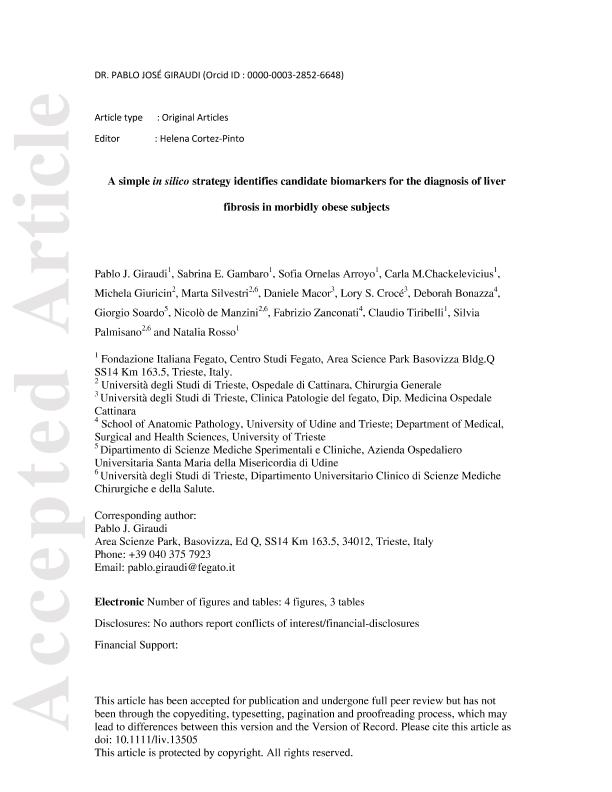Artículo
A simple in silico strategy identifies candidate biomarkers for the diagnosis of liver fibrosis in morbidly obese subjects
Giraudi, Pablo J.; Gambaro, Sabrina Eliana ; Ornelas Arroyo, Sofia; Chackelevicius, Carla M.; Giuricin, Michela; Silvestri, Marta; Macor, Daniele; Crocé, Lory S.; Bonazza, Deborah; Soardo, Giorgio; de Manzini, Nicolò; Zanconati, Fabrizio; Tiribelli, Claudio; Palmisano, Silvia; Rosso, Natalia
; Ornelas Arroyo, Sofia; Chackelevicius, Carla M.; Giuricin, Michela; Silvestri, Marta; Macor, Daniele; Crocé, Lory S.; Bonazza, Deborah; Soardo, Giorgio; de Manzini, Nicolò; Zanconati, Fabrizio; Tiribelli, Claudio; Palmisano, Silvia; Rosso, Natalia
 ; Ornelas Arroyo, Sofia; Chackelevicius, Carla M.; Giuricin, Michela; Silvestri, Marta; Macor, Daniele; Crocé, Lory S.; Bonazza, Deborah; Soardo, Giorgio; de Manzini, Nicolò; Zanconati, Fabrizio; Tiribelli, Claudio; Palmisano, Silvia; Rosso, Natalia
; Ornelas Arroyo, Sofia; Chackelevicius, Carla M.; Giuricin, Michela; Silvestri, Marta; Macor, Daniele; Crocé, Lory S.; Bonazza, Deborah; Soardo, Giorgio; de Manzini, Nicolò; Zanconati, Fabrizio; Tiribelli, Claudio; Palmisano, Silvia; Rosso, Natalia
Fecha de publicación:
01/2018
Editorial:
Wiley Blackwell Publishing, Inc
Revista:
Liver International
ISSN:
1478-3223
Idioma:
Inglés
Tipo de recurso:
Artículo publicado
Clasificación temática:
Resumen
Background & Aims: Non-alcoholic fatty liver disease (NAFLD) is a chronic liver disorder, tightly associated with obesity. The histological spectrum of the disease ranges from simple steatosis to steatohepatitis, with different stages of fibrosis, and fibrosis stage is the most significant predictor of mortality in NAFLD. Liver biopsy continues to be the gold standard for its diagnosis and reliable non-invasive diagnostic tools are unavailable. We investigated the accuracy of candidate proteins, identified by an in silico approach, as biomarkers for diagnosis of fibrosis. Methods: Seventy-one morbidly obese (MO) subjects with biopsy-proven NAFLD were enrolled, and the cohort was subdivided according to minimal (F0/F1) or moderate (F2/F3) fibrosis. The plasmatic level of CD44 antigen (CD44), secreted protein acidic and rich in cysteine (SPARC), epidermal growth factor receptor (EGFR) and insulin-like growth factor 2 (IGF2) were determined by ELISA. Significant associations between plasmatic levels and histological fibrosis were determined by correlation analysis and the diagnostic accuracy by the area under receiver operating characteristic curves (AUROC). Results: Eighty-two percentage of the subjects had F0/F1 and 18% with F2/F3 fibrosis. Plasmatic levels of IGF2, EGFR and their ratio (EGFR/IGF2) were associated with liver fibrosis, correlating inversely for IGF2 (P <.006) and directly (P <.018; P <.0001) for EGFR and EGFR/IGF2 respectively. The IGF2 marker had the best diagnostic accuracy for moderate fibrosis (AUROC 0.83), followed by EGFR/IGF2 ratio (AUROC 0.79) and EGFR (AUROC 0.71). Conclusions: Our study supports the potential utility of IGF2 and EGFR as non-invasive diagnostic biomarkers for liver fibrosis in morbidly obese subjects.
Palabras clave:
Biomarkers
,
In Silico Strategy
,
Liver Fibrosis
,
Morbidly Obese
Archivos asociados
Licencia
Identificadores
Colecciones
Articulos(IMBICE)
Articulos de INST.MULTIDISCIPL.DE BIOLOGIA CELULAR (I)
Articulos de INST.MULTIDISCIPL.DE BIOLOGIA CELULAR (I)
Citación
Giraudi, Pablo J.; Gambaro, Sabrina Eliana; Ornelas Arroyo, Sofia; Chackelevicius, Carla M.; Giuricin, Michela; et al.; A simple in silico strategy identifies candidate biomarkers for the diagnosis of liver fibrosis in morbidly obese subjects; Wiley Blackwell Publishing, Inc; Liver International; 38; 1; 1-2018; 155-163
Compartir
Altmétricas



